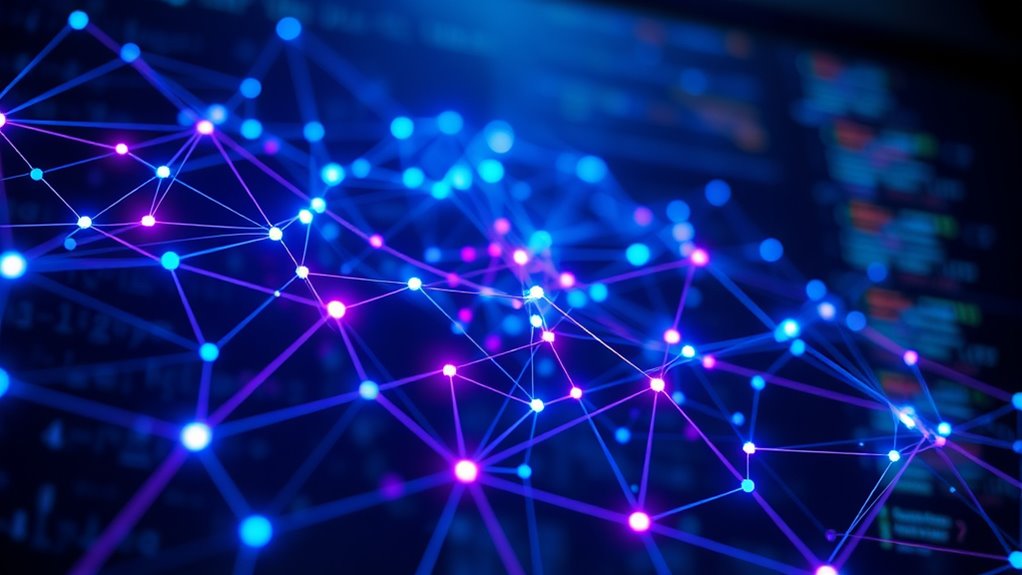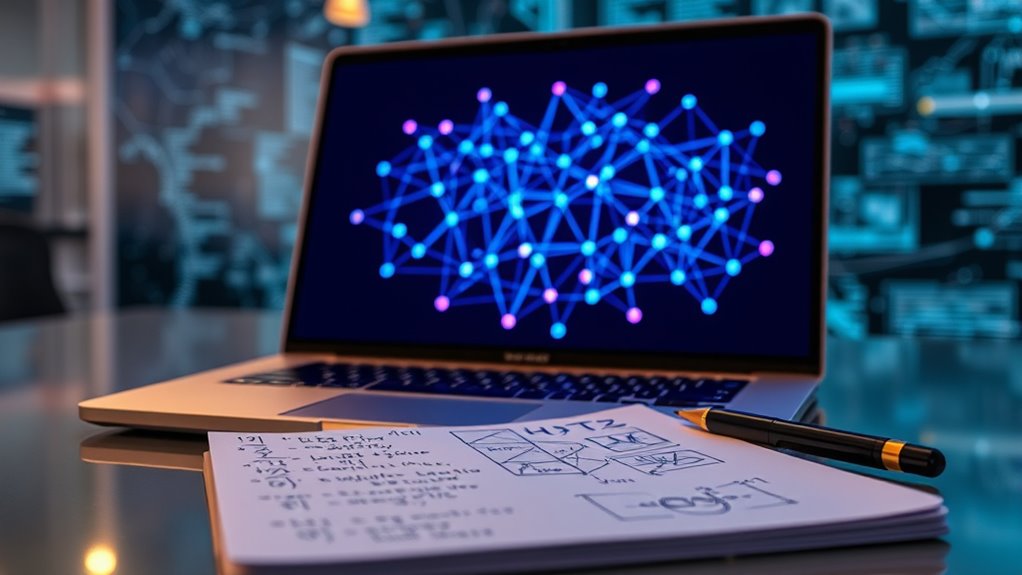Graph neural networks analyze link data by modeling how nodes connect within a system’s structure. They use message passing to share information between neighboring nodes, updating their features based on both local and global context. Aggregation functions like sum or neural transforms help capture complex relationships. This mathematical process enables accurate prediction of existing or potential links. If you keep exploring, you’ll uncover the tradecraft behind how these neural techniques uncover hidden relationships in interconnected data.
Key Takeaways
- GNNs encode local node environments through message passing, enabling accurate prediction of existing and potential links.
- Aggregation functions (sum, mean, neural transforms) combine neighbor information to update node features iteratively.
- Multi-layer GNNs capture both local and global network patterns, improving link analysis precision.
- Scalability techniques like mini-batching allow GNNs to handle large, complex networks efficiently.
- The mathematical core involves learning functions that map node embeddings to link existence probabilities based on graph structure.

Have you ever wondered how complex networks like social media, transportation systems, or biological interactions can be effectively analyzed? The answer lies in the power of Graph Neural Networks (GNNs), a cutting-edge approach that leverages the structure of data itself. Unlike traditional models that treat data points as isolated entities, GNNs recognize that many real-world systems are naturally interconnected, represented as graphs where nodes symbolize entities and edges depict relationships. This perspective allows you to capture the nuanced dependencies and patterns within the network, providing a richer understanding that’s essential for tasks like link prediction, node classification, and community detection.
When you focus on link analysis, you’re essentially trying to predict whether a connection exists or might form between two nodes. GNNs excel here because they learn to encode each node’s local environment—its neighbors, the features of those neighbors, and the overall network topology—into a meaningful vector representation. This process involves message passing, where information flows along edges, enabling nodes to update their features based on their neighbors’ data. By iterating this process across multiple layers, the network develops a deep understanding of the network’s structure, allowing you to identify hidden or future links with greater accuracy.
The math behind GNNs might seem intimidating at first, but it’s fundamentally about aggregating and transforming data. You start with initial features for each node and pass messages along the edges, combining neighbor information through functions like summation, averaging, or more sophisticated neural transformations. These aggregated signals are then used to update each node’s feature vector. Over successive layers, the node representations become increasingly context-aware, capturing local and global patterns simultaneously. The goal is to learn a function that maps these rich embeddings to a probability of link existence, so you can predict unseen or missing connections within the network.
What makes GNNs so powerful for link analysis is their ability to adapt to different types of graphs and data features. Whether you’re dealing with social networks, financial transactions, or molecular structures, GNNs can incorporate various attributes and relationships to refine their predictions. They also scale reasonably well with the size of the network, especially when optimized with techniques like mini-batching or sampling. Additionally, understanding how to maximize model efficiency can significantly improve the performance of GNNs on large datasets. As you explore this math, you’ll see that at its core, GNNs harness the structure of the data itself, turning complex, interconnected systems into actionable insights, all driven by the elegant interplay of graph theory and neural computation.
Frequently Asked Questions
How Do GNNS Compare to Traditional Link Analysis Methods?
GNNs outperform traditional link analysis methods by capturing complex relationships and patterns in graph data more effectively. Unlike classic techniques, which often rely on heuristics or simple metrics, GNNs learn to represent nodes and edges through training, improving accuracy in tasks like link prediction and community detection. You’ll find GNNs more adaptable and scalable, especially with large, dynamic networks, making them a powerful tool for modern link analysis challenges.
What Challenges Exist in Scaling GNNS for Large Networks?
Scaling GNNs for large networks is like trying to fit a forest into a tiny jar—you face immense computational demands and memory constraints. You’ll encounter challenges in training efficiency, as processing vast amounts of data slows down, and in maintaining accuracy across millions of nodes. To overcome this, you need to optimize algorithms, leverage distributed computing, and develop scalable architectures that handle big data without sacrificing performance.
Are There Real-World Applications Where GNN Link Analysis Excels?
You’ll find GNN link analysis excels in social network analysis, where it uncovers hidden relationships and influential nodes. It’s also highly effective in fraud detection, identifying suspicious activity by analyzing transaction networks. Additionally, GNNs help in recommendation systems by understanding user-item interactions. In cybersecurity, they detect vulnerabilities and malicious links. Overall, GNNs provide deep insights into complex networks, making them invaluable for tasks involving interconnected data.
How Does GNN Handle Dynamic or Evolving Network Structures?
Imagine a network like a flowing river, constantly shifting as new streams join or currents change. GNNs handle this by updating node representations as the structure evolves, learning from new connections just like a traveler adapts to changing scenery. They incorporate temporal information and dynamic graph algorithms, allowing you to analyze real-time changes effectively. This keeps your insights fresh, accurate, and adaptable to the network’s ever-changing landscape.
What Are the Limitations of Current GNN Models in Link Prediction?
You might find that current GNN models struggle with scalability when dealing with large, complex networks, as computations become intensive. They also often rely heavily on the quality of input data, leading to poor predictions if data is noisy or incomplete. Additionally, GNNs can have difficulty capturing long-range dependencies, limiting their effectiveness in predicting links across distant nodes. These limitations highlight areas for ongoing research and improvement in GNN technology.
Conclusion
You now see how Graph Neural Networks revolutionize link analysis, turning complex data into powerful insights. With their ability to capture intricate relationships, you can uncover secrets hiding in plain sight—like a detective wielding unmatched math magic. These tools are transforming industries faster than you can imagine, making traditional methods seem antiquated. Embrace this technology, and you’ll gain access to the true potential of your data, proving that in the world of networks, GNNs are the ultimate game-changer.








